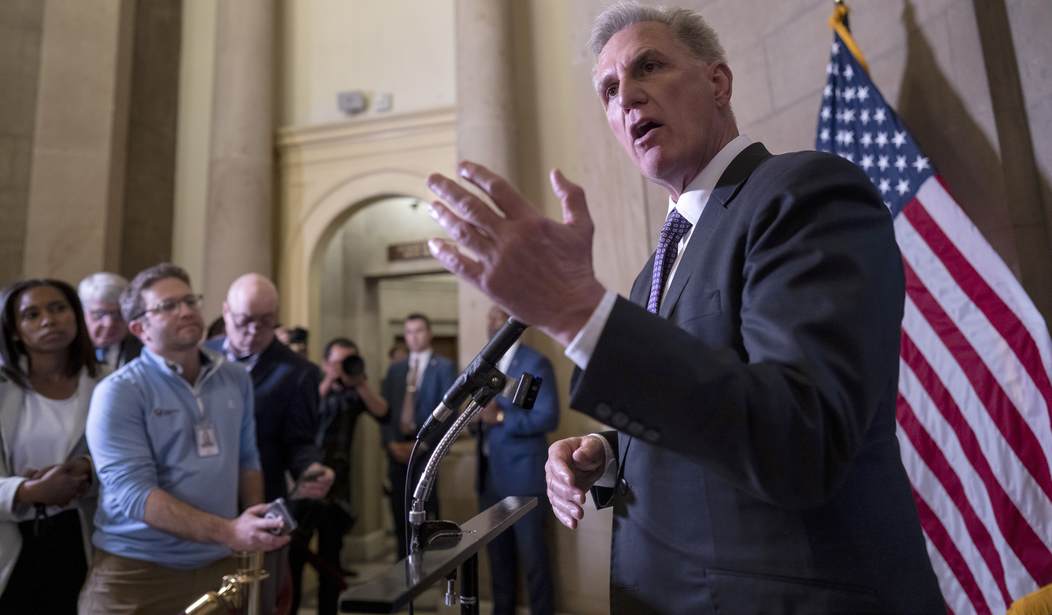House Republicans are in another titanic battle with President Joe Biden on how to balance the budget. Actually, it's a lopsided debate because Democrats have no interest at all in reducing the deficit. They are operating under the delusional idea paradigm of "Modern Monetary Theory," which posits that the U.S. government can borrow $2 trillion from now until the end of days and it won't hurt the economy.
Were these presidential advisers the same Nobel-winning economic sages who swore in the pages of The New York Times that, don't worry, Mr. Biden, your $6 trillion spending spree won't cause inflation?
Those of us who live down in here in the real world are horrified by the fiscal future we're facing. Any week now, our publicly traded debt will exceed 100% of our total annual national output, and that percentage gobbled up by government debt is expected to accelerate from 100% of gross domestic product today to nearly 200% over the next 30 years. That's the path to Argentina, Bolivia and Zimbabwe.
There's plenty to cut in the budget, and House Budget Committee Chair Jodey Arrington (R-Texas) has put forward a financially fit budget that would chop hundreds of billions of dollars a year of waste, fraud, redundancy and obsolescence.
Here's another way to shave off $380 billion of spending right out of the gate: kill Biden's green energy slush fund, which is being run by Democratic politico John Podesta. How about allowing the production of energy that pays taxes -- the oil, natural gas and coal industry -- instead of "renewable" energy that eats hundreds of billions of tax dollars?
But it doesn't matter how much chainsawing that Republicans could possibly do -- even if they had the political will to do it -- these reforms still won't get us within a country mile of a balanced budget.
Recommended
That's because there isn't enough economic growth to get the revenues to catch up with the spending. Under Biden, the U.S. economy has grown at roughly a 1.5% growth path -- pretty pathetic given that coming out of COVID-19, we should have been booming.
Worse yet, the standard forecast from the Congressional Budget Office is predicated on the assumption of 1.7% annual economic growth. But that's way below the 3.2% average real growth rate of the U.S. economy from 1950-2005.
To borrow a phrase from John F. Kennedy when he was running for president in 1960: "We can do better." Actually, a lot better.
Former President Donald Trump gets this. So does Vivek Ramaswamy. When you get more growth, you get more revenues and less spending on social welfare programs. Ramaswamy says it well: "If we get back to 3%-plus economic growth, the fiscal problems start to go away." Conservative and liberal economists alike have scolded the Trump-Ramaswamy strategy for concluding that "we can grow our way out of the deficit."
Actually, with a modicum of the spending restraint and a higher growth path, we can avoid the fiscal train wreck.
Committee to Unleash Prosperity economist Louis Woodhill finds that the debt as a share of GDP slopes steadily downward over the next 30 years with a 3% trajectory of growth. And if we achieve 3.5% growth, we can even reach a point where we start paying down the debt. This is called the power of compounding. What a change that would be from a trillion dollars a year in red ink added forever -- which is the Biden baseline.
This also means that any policy that lowers growth -- for example, not drilling for U.S. oil and gas -- makes the deficit forecast worse.
This is why tax increases on investment and work are so counterproductive. Those taxes would reduce investment and growth and make a balanced budget even more unachievable. Under President Bill Clinton, we had fast growth, spending restraint, and a booming stock market; three years later, we had a balanced budget.
What if our politicians set a national priority to do everything humanly possible to make the economy grow at between 3% and 3.5%, not the anemic growth rate of that pace as the CBO predicts? Many people think that's impossible because of low birth rates and low labor force growth, but we can and should import the workers we need -- especially the brainiacs -- from the rest of the world to keep labor force growth from shrinking.
We can achieve bursts of growth from the next age of hypertechnological advances in areas like energy production, robotics, artificial intelligence, and gene therapy that could make the internet revolution look like a blip. New billion-dollar factories will be filled with very fewer workers and a lot of robots -- which translates into gigantic leaps forward in productivity that could make 3% growth a layup.
There is one more virtue of a growth agenda: Americans want prosperity far more than they want a balanced budget. We all want a balanced federal budget in principle, but more important to voters is that their own family budget is growing.

























Join the conversation as a VIP Member